Digital Architecture and Intelligent Buildings: A Suitable Approach to Proper Implementation of Sustainable Development Components in the Third Millennium
Saeid Hasanpour Loumer1 *
1
Department of Architecture,
College of Art and Architecture,
Khalkhal Branch, Islamic Azad University and Researchers and Elites Club of Khalkhal,
Iran
Corresponding author Email: s.hasanpuor@Aukh.ac.ir
DOI: http://dx.doi.org/10.12944/CWE.10.Special-Issue1.11
This study was an attempt to analyze digital architecture and intelligent constructions which are aimed at actualizing the components of sustainable development. It was a descriptive-analytical desk research the results of which indicated that architecture and other sciences have to be able to address the concerns and needs of present and future generations. Digital architecture and intelligent buildings have successfully led to adequate savings in economic, social and environmental costs. They have reduced environmental pollution, climate chances, and mental problems of humans. They have also played a significant role in providing a healthy life to humans as one of the major components of sustainable development.
Copy the following to cite this article:
Loumer S. H. Digital Architecture and Intelligent Buildings: A Suitable Approach to Proper Implementation of Sustainable Development Components in the Third Millennium. Special Issue of Curr World Environ 2015;10(Special Issue May 2015). DOI:http://dx.doi.org/10.12944/CWE.10.Special-Issue1.11
Copy the following to cite this URL:
Loumer S. H. Digital Architecture and Intelligent Buildings: A Suitable Approach to Proper Implementation of Sustainable Development Components in the Third Millennium. Special Issue of Curr World Environ 2015;10(Special Issue May 2015). Available from: http://www.cwejournal.org?p=719/
Download article (pdf) Citation Manager Publish History
Select type of program for download
| Endnote EndNote format (Mac & Win) | |
| Reference Manager Ris format (Win only) | |
| Procite Ris format (Win only) | |
| Medlars Format | |
| RefWorks Format RefWorks format (Mac & Win) | |
| BibTex Format BibTex format (Mac & Win) |
Article Publishing History
| Received: | 2014-11-06 |
|---|---|
| Accepted: | 2014-12-16 |
Introduction
In the course of history, architecture has always presented the manifestations of different social attitudes. There has always been a strong link between architecture and social evolutions. Many changes have also occurred to architecture as a result of social changes. Some of these changes can be observed in the present age which is the age of information. The current age, as the age of computers and the Internet, has made significant changes to the trend of evolution of architecture (Abasi, 2010). This digital revolution has been formed on the basis of concurrency, genesis, immediacy, and globalization and is focused on the information and communication technology. It has changed the trends of thought, product, consumption, commerce, management, communication, life and environment. It is also rapidly reshaping the material basis of the society. The information and communication technology has provided for the emergence of a network society. It has given a new identity to it and has presented new definitions of human as a creature (Castells, 2010). Transmission, examination, control and management practices conducted by digital systems are useful due to the richness and high capacity of information in digital systems and the synchronization between the environment and digital systems (Jamkhedkar et al., 2009) In the present research, it was tried to express the necessity of digital architecture and intelligent buildings in the third millennium. It was also tried to explain why the spread of this architecture style can considerably contribute to the actualization of the notion of sustainable development.
Digital Architecture
Digital architecture has to provide an environment suitable for the exchange of knowledge information by employing images, lightings, visualizations, etc. It shall help users benefit from mutual interactions (Hashem nejad et al., 2010). Accordingly, we need a fully new communication environment with some certain architecture to be able to organize this large volume of communications. According to Esterhoise, we need a new generation of architects to not only design buildings, but also to plan for them. We need architects that instead of collaborating with structural and mechanical engineers work with computer engineers and digital designers. They are the new generation of architects (Oosterhuis, 2003). According to the theories of digital architecture, computer systems give unbiased identity to user ideas (Kotnik, 2010) The increasing use of computer in the fields of design, architecture, and engineering is one of the most important recent achievements aimed to improve the design process and efficiency of different stages of design to implementation of projects (Glabchy et al., 2013). In spite of the short history of digital architecture, it has managed to grow significantly by relying on new technologies. It is similar to a small-scale revolution changing into a great revolution whose different aspects will be expressed in the close future.
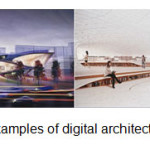 |
|
In fact, digitalization of the construction and design process by humans and software (numerical models) in the digital era leads to the actualization of the intrinsic properties of materials and adds to the conformity between materials and design context. The presence of numbers and complex structures in the whole and every piece of materials can address the limitations on the design of large-scale structures. It can also bring about proportion and conformity to the relationship between the architectural aesthetic form and structure of digital structures (Willmann et al., 2013). With digital architecture it is possible to actualize many dynamic and nonlinear ideas using light-weight recoverable materials as well as precise robots, software, and satellite controllers (e.g. GPS). These ideas can be planned and implemented by producing pieces in factories or on-site workshops (Bertol et al., 1997)
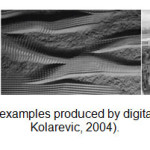 |
|
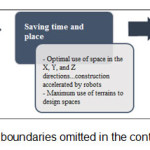 |
|
Intelligent Buildings
Intelligent buildings add to the enjoyment, accelerate activities, reduce environmental damages, and are very important and effective from the economic, social and ecological point of views (Snoonian, 2003) In the last two decades manufacturers and designers working in the construction and energy fields have examined the theoretical and practical significance of intelligent optimization and control of buildings using intelligent remote systems (Sinopoli, 2006). Intelligent buildings are a combination of the following two words: intelligent (i.e. something with intelligence and logic) and building (i.e. a structure built as a residence or refuge or as a workshop dividing the space into an interior and an exterior space). Therefore, “intelligent building” refers to a refuge with intelligent behavior housing internal and external events. Considering the climatic changes in the 21st century, intelligent buildings are designed for the third millennium (Ting-pat So et al., 1999).
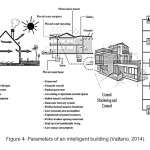 |
|
The Existing Intelligent Buildings Are Divided Into Two Groups:
- Equipping the building in a specific period of time: Old buildings which are governed by the decisions of the residents demonstrate non-sustainable savings and organized planning practices.
- Concurrency of installation and design of intelligent systems in buildings: In this case, the building acts fully intelligent and faults are minimized. Savings happen in the energy, environment, convenience, economic and social sectors and benefit the residents and the society )Sinopoli, 2009).
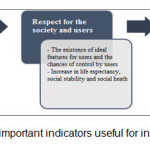 |
|
Sustainable Development
Sustainability has its roots in valuing and keeping theoretical and practical ideals. This goes beyond the realm of material and physics and applies to the notions of society and future and present relations as well. It also includes mutual respect for natural and human properties as well as other elements necessary for living (Hasanpour Loumer et al., 2014). Concerns for the sustainable development approaches have increased recently. These approaches cover the environmental, economic, social and cultural dimensions (Hasanpour Loumer et al., 2014). Implementation of sustainable development plans is inevitable in the developed and developing countries because it is not possible to move toward development without long-term formulated plans (Bolcárová et al., 2015).
Table1: Analysis of the major and minor indicators of sustainable development components
|
1. |
Sustainable protection, reconstruction and use of ground ecosystems (resource management) |
2. |
Use of global collaboration to eradicate racism |
|
3. |
Use of suitable infrastructure in the design of cities along with intelligent architecture |
4. |
Promoting healthy life and social welfare for all people at all different ages |
|
5. |
Use of renewable cost-effective energies by the whole society |
6. |
Access to gender equality ad empowerment of women and girls |
|
7. |
Elimination of hunger, food security and promotion of sustainable agriculture. |
8. |
Mitigation of inequalities, sanctions and international relations |
|
9. |
Proper planning for climatic changes |
10. |
Sustainable economic development and employment for the whole society |
|
11. |
Use of vast marine resources for useful social needs |
12. |
Providing human-centered, flexible and sustainable cities |
|
13. |
Sustainable management of water and wastewater and Development of education and training |
14. |
Balance between consumptions and production |
|
15. |
Ending poverty |
16. |
Global peace and security |
Sustainable Development Components
Environmental Dimension
The reduction in environmental effects and losses, an increase in sustainability and sustainable development (A Rosen and Dincer, 2001). Use of renewable fuels (Gasparatos et al., 2009) omission of greenhouse gases, use of renewable systems and energies and moving toward increased productivity and omission of the future of energy are the factors influencing sustainable development (Markides, 2013). According to the studies by The Organization for Economic Co-operation and Development (OECD) in 2009, the share of fossil fuels from greenhouse gases is 84%. Results suggest that the only cause of the reduction and omission of pollutions is the lack of implementation of sustainable development plans (Blohmke, 2014). Regarding environmental changes it is tried to maintain and reinforce physical, biological and ecological resources. The relationship between nature and human was also studied in these studies (Zahedi et al., 2006).
Social Dimension
Development has to make people capable of unlocking their potential abilities and move toward perfection and a dignified life. A long healthy life calls for education, access to the required resources, adequate income, political freedom, respect for human rights, immunity to humiliation, and some other norms. Social sustainable development is achieved with an improvement in these fields. The social aspect deals with the mutual relationships between humans, increased welfare, health and education services, development of different cultures, equality and elimination of poverty (Zahedi et al., 2006).
Economic Dimension
The economic dimension deals with economic growth and other economic parameters. It is concerned with maximizing the welfare of individuals and societies through optimal and efficient use of natural resources and fair distribution of interests. In this dimension, the objective is to enhance structures and help people achieve full growth of financial power (Bartle et al., 2007).
Millennium Development Goals (MDGs)
Following the earth summit and announcement of the world development agenda, in September 2000 the United Nations General Assembly issued a statement and passed the United Nations’ statement on the third millennium. By setting eight goals the Millennium Statement shows the path to sustainable economic, social and environmental development.
Table2: Analysis of the millennium development goals (Atuah, 2014).
|
Objective one |
Eliminating intense poverty and hunger |
Objective five |
Improving mothers’ health |
|
Objective two |
Providing access to primary educations in the world |
Objective six |
Fighting AIDS and its virus |
|
Objective three |
Development of gender equality and empowerment of women |
Objective seven |
Guaranteeing environmental sustainability |
|
Objective four |
Reduction in child mortality |
Objective eight |
Global cooperation for development |
Sustainable Development and Architecture
From the philosophical point of view, sustainable development is based on the notion of intergenerational justice in the use of the environment (Farahani fard, 2010). Sustainable development calls for changes in the use of resources, giving directions to investments, orientation of technological development, and institutional changes in relation to present and future needs. It is the practice of saving rare resources and taking careful measures to use renewable abundant resources (Nohi, 1995). Architecture is the creative demonstration of the environment using identity, cultural and environmental components of the society. This demonstration leads to mental and physical convenience of users. Architecture is the response to different needs forming its different aspects (Mahvash, 2007). Sustainable development has had a comprehensive approach toward current trends and damages caused in the past decades especially through the channel sustainable development. One of the ways of accessing sustainable development is providing for the cooperation of experts. This way it not only is possible to address the problems of previous decades, but also is possible to protect the existing resources and pass a clean Earth to future generations (Khatami et al., 2010). Architecture shall focus on reducing climatic environmental effects as well as physiological convenience and proper use of natural resources, energy and spaces (Cettina Gallo, 2000).
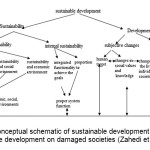 |
|
Sustainable Development Principles
In order for a building to be considered a sustainable building the following standards shall be applied:
- Use of new technologies and intelligent buildings.
- Providing conceptual and physical consistency between the building and social.
- culture and identity
- Futurism and holism
- Meeting residents’ needs
- Conformity with climate
- Saving energy (Zandiyeh et al., 2010).
Analysis of the Consistency of Architecture (Digital Architecture and Intelligent Buildings) to Attain Sustainable Development Goals:
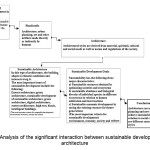 |
|
Conclusion
Digital architecture has brought designers, architects and digital intellectuals together. The practice of application of digital technologies is aimed at linking design and construction in architectural projects. Use of digital tools to increase the intelligence of designing and its approach to architecture as a science that has to be actualized both objectively and subjectively. The ultimate goal of digital architecture is to build a four-dimensional model including all of the information required for design and digital production along with schedule information required for the assembly of the project. This information source enables architects to acts as the coordinator of information between all professions and industries involved in construction of buildings. Intelligent designs and buildings planned and constructed through precise systems can considerably help save energy, convenience and health of the soul and body of house residents as well as cities (at a larger scale). Dynamic programmable buildings provide for proper interaction with natural environments. They, in fact, establish a proper significant connection with their environments and take advantage of natural disasters to attain the objectives of energy acquisition, wealth creation and protection of the environment. Based on the results of examinations of digital architecture and intelligent buildings, which are necessary for the third millennium, the saving of economic, social, environmental, and cultural capitals is necessary for sustainable development. In fact, understanding and commonalities of groups help achieve long- and short-term goals more quickly and prevent future challenges and losses of material and spiritual costs. In addition, the main objective of sustainable development is formulated and permanent progress accompanied by planning for welfare and protection of the material and spiritual ideals of societies.
Suggestions
Integration of Public and Private Sector Plans for the Qualitative and quantitative Growth of the Society
Proper planning by the government and private sector can provide the economic foundations and improve the financial power of all social classes. In this case, members of the society can build intelligent buildings with higher efficiency, longer lifetime, and more suitability for the life of humans and the environment.
Improving the Quality of Buildings
“Building shall act as chameleons” (Kerr and Gibson, 2003) and shall adapt to changes in the theoretical and applied sciences (e.g. through use of new sciences, computer analyses, and use of recoverable materials flexible to natural and non-natural disasters and conditions).
Saving Cultural Identities in Architecture
Updating the conceptual, physical and cultural elements of societies in relation to the needs of future and present generations.
Support for the Environment
Use of design in accordance with sciences, computers, and digital architecture along with the use of intelligent buildings and green buildings can considerably contribute to the reduction in greenhouse gases and environmental damages.
Improving Health Conditions
In advanced buildings, different control systems can be used to prevent problems associated with ventilation, cooling, heating, waste dumping, and nesting/intrusion of insects. In fact, internal and external walls are protected by digital and intelligent systems. All of the features available in the advanced intelligent buildings lead to the qualitative and quantitative improvement of the lives of their users.
References
- A Rosen, M.; Dincer, I. Exergy as the confluence of energy, environment and sustainable development. Exergy, An International Journal,1, 3–13 (2001).
- Aiello, C., Evolo. Digital and Parametric Architecture (Evolo,2014).
- Atuah, J. Making a case for a public health orientation in global pharmacy education and practice in the context of the Millennium Development Goals (MDGs). Journal of Currents in Pharmacy Teaching and Learning, 6,723-729 (2014).
- Abasi, Z. Computer algorithms in digital architecture. Journal Project Management (Engineering, Architecture and Urban Planning), 76, 60–65 (2010).
- Blohmke, J. Technology complexity, technology transfer mechanisms and sustainable development. Journal of Energy for Sustainable Development, 23, 237-246 (2014).
- Bolcárová, P.; Kološta, S. Assessment of sustainable development in the EU 27 using aggregated SD index. Journal of Ecological Indicators, 48, 699–705 (2015).
- Bartle, I.; Vass, P. Independent economic regulation: A reassessment of its role in sustainable development. Journal of Utilities Policy, 15, 261-269 (2007).
- Bertol, D., Foell, D. Designing Digital Space: An Architect's Guide to Virtual Reality (John Wiley & Sons 1997).
- Cettina Gallo, A. Chapter 70 – Architecture for Sustainable Development. Journal of World Renewable Energy Congress VI, 15, 362-366 (2000).
- Castells, M. The Rise of the Network Society: The Information Age: Economy, Society, and Culture Volume I (Wiley-Blackwell, 2010).
- Farahani fard, S. Theological foundations of permanent development. Journal of Philosophy of Religion, 7, 41–56 (2010).
- Glabchy, M., Andaj Grmarvdy, A., Bastani, H. Digital architecture (application technologies, CAD / CAM / CAE in architecture) (Tehran University, 2013).
- Gasparatos, A.; El-Haram, M. and Horner, M. Assessing the sustainability of the UK society using thermodynamic concepts: Part 2. Journal of Renewable and Sustainable Energy Reviews,13, 956–970 (2009).
- Hasanpour Loumer, S.; Sattari Sarbangholi, H. and Toofan, S. Designing the Residential Places for Tourists Based on Environmental Factors and Green Architecture: A Case Study in Historical City of Masouleh. Journal of Natural and Social Sciences, 3, 39–46 (2014).
- Hasanpour Loumer, S.; Sattari Sarebangholi, H. The Study and Analysis of the Components of Sustainable Development of the Historical City of Masuleh, Proceedings of the 1th International Conference on Urban Development Based on New Technologies, March 6, Thursday, sanandaj, Iran (2014).
- Hashem nejad, H.; Shangehpour, S. A design pattern of virtual architecture for social interaction in Iran Case study: Iranian architecture society. Journal Honar-Ha-Ye-Ziba (Memari-Va-Shahrsazi), 44, 5–14 (2010).
- Jamkhedkar, P.; Heileman, G. Digital rights management architectures. Journal of Numerical Computers & Electrical Engineering, 35, 376–394 (2009).
- Kerr, J., Gibson, A. London from Punk to Blair (Reaktion Book, 2003).
- Kotnik, T. Digital Architectural Design as Exploration of Computable Functions. International Journal of Architectural Computing, 8, 1–16 (2010).
- Kolarevic, B. Architecture in the Digital Age: Design and Manufacturing (Taylor & Francis, 2004).
- Leach, N., Turnbull, D., Williams, Ch. Digital Tectonics (John Wiley & Sons, 2004).
- Markides, C. The role of pumped and waste heat technologies in a high-efficiency sustainable energy future for the UK. Journal of Applied Thermal Engineering, 53, 197–209 (2013).
- Mahvash, M. Architectural expression: corporeal manifestation of the essence of Architecture, Journal of Honar-Ha-Ye-Ziba, Zandiyeh, M and Parvardi Nejad, S. Sustainable Development and it’s Concept in Housing Architecture of Iran. Journal of Housing and Rurar Environment, 29, 2–21 (2010).
- Nohi, S. Ecology and development philosophy for the 21st century (Cultural Kian,1995).
- Oosterhuis, K. Hyperbodies - Towards an E-motive Architecture (Birkhauser, 2003).
- Snoonian, D. Smart buildings. Journal of Spectrum, IEEE, 40, 18–23 (2003).
- Sinopoli, J. Smart Buildings: A Handbook for the design and operation of Buliding Technology Systems (Spicewood, 2006).
- Sinopoli, J.M. Smart Buildings Systems for Architects, Owners and Builders (Elsevier Inc, 2009).
- Ting-pat So, A., Lok Chan, W. Intelligent Building Systems (Kluwer Academic, 1999).
- Vattano, S. Smart Buildings for A Sustainable Development. Journal of Economics World, 2, 310–324 (2014).
- Willmann, J., Gramazio, F., Kohler, M., Langenberg, S. Digital by Material (Springer-Verlag/Wien, 2013).
- Zahedi, Sh.; Najafi, Gh. Sustainable Development, A New Conceptual Framework. Journal of Management Research in Iran, 10, 43–76 (2006).







